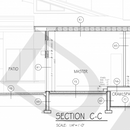Bedroom slab on grade: why not add a huge amount of thermal mass below the slab and above the insulation?
Our new home we’re close to breaking ground on will have a master bedroom as a slab on grade, while the rest of the home is on a crawlspace. The entire main floor including the bedroom will have hydronic heat.
(Aside: the reason for this is because we’re on a lake and there’s a minimum flood-construction level that applies to the floor assembly. But it applies to the _bottom_ of the joists for wood floors but the _top_ of the slab for slabs on grade. This allowed us to design our bedroom a foot lower and closer to the water.)
The architect spec’d a 5″ reinforced slab on 6mil poly on 4″ rigid insulation on 6″ compacted gravel on top of fill. But this got me thinking: since they need to dig way down anyways for the footings and foundation walls (see image below), why not put the foam closer to the footings, so that all the fill (which is gravelly sand in my area) serves as a big thermal mass?
(From one of Martin’s article, I understand that we’d want to keep the poly directly below the concrete slab to avoid moisture problems with the wood flooring that will go on top).
The heat capacity of the concrete slab is:
15′ x 13′ x 5/12 = 81 cubic feet
81 cu ft x 145 lbs / cu ft = 12,000 lbs
12,000 lbs x 0.2 BTU/lbs/degF = 2400 BTU/degF
= 1.3 kW-hr / degC
But if there’s three or four feet of gravel below, then it’s probably closer to 10 kW-hr/deg C or 20,000 BTU/degF. That means the bedroom could absorb 10 kW-hr of heat in the afternoon and only shift 1 degC in temperature (obviously I’m simplifying here).
I could imagine this helping to keep the bedroom cool throughout the day in the summertime, and it wouldn’t seem to add any real cost. To me it seems like it would have only upside, but I don’t have any construction experience, which is why I’m asking you guys!
Any downside to doing this?
GBA Detail Library
A collection of one thousand construction details organized by climate and house part










Replies
The problem is that you won't get enough heat transfer to the fill to make a difference. A tile floor (and just the slab as thermal mass) would be worth a little.
What climate zone is this (is that a flat roof with air permeable insulation)?
Yes, I think you're right. According to the numbers on my drawings, compacted gravel has an R value of about 0.2 per inch, or R4.8 for 2' depth. With a 1 deg C delta T, the flow of thermal energy from the bedroom into the gravel will only be about 15W. The delta T required to get a decent flow into the "thermal mass" at that depth would mean the room was already very uncomfortable!
I guess thermal mass is a lot more effective if it's "thermally closer" to the place you need the heat or coolth. More mass at a deeper depth has diminishing returns. Thanks for helping me see this!
The home will be on Harrison Lake near Vancouver, Canada. So climate zone 4c (marine). The roof is pitched in the plane you can't see at 2.5/12.